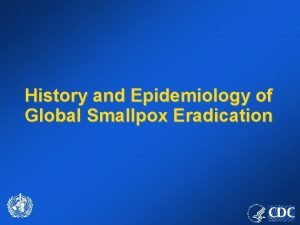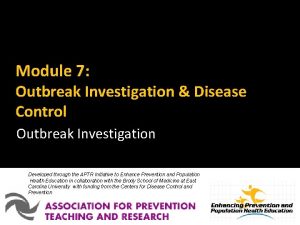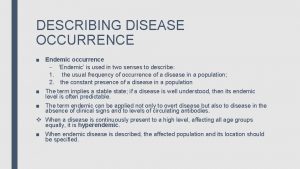EPIDEMIOLOGY DR FATMA KALIFA Endemic It refers to









- Slides: 9

EPIDEMIOLOGY DR FATMA KALIFA

Endemic • It refers to the constant presence of a disease or infectious agent within a given geographic area or population group. It is the usual or expected frequency of disease within a population. • (En = in; demos = people)

Epidemic • “The unusual occurrence in a community of disease, specific health related behavior, or other health related events clearly in excess of expected occurrence” • (epi= upon; demos= people) • Epidemics can occur upon endemic states too.

Hyperendemic and holoendemic • The term “hyperendemic” expresses that the disease is constantly present at high incidence and/or prevalence rate and affects all age groups equally. • The term “holoendemic” expresses a high level of infection beginning early in life and affecting most of the child population, leading to a state of equilibrium such that the adult population shows evidence of the disease much less commonly than do the children (e. g. malaria)

Pandemic and Exotic • An epidemic usually affecting a large proportion of the population, occuring over a wide geographic area such as a section of a nation, the entire nation, a continent or the world, e. g. Influenza pandemics. • Exotic diseases are those which are imported into a country in which they do not otherwise occur, as for example, rabies in the UK.

Sporadic • The word sporadic means “scattered about”. The cases occur irregularly, haphazardly from time to time, and generally infrequently. The cases are few and separated widely in time and place that they show no or little connection with each other, nor a recognizable common source of infection e. g. polio, meningococcal meningitis, tetanus…. • However, a sporadic disease could be the starting point of an epidemic when the conditions are favorable for its spread.

Zoonosis, epizootic and enzootic • Zoonosis is an infection that is transmissible under natural conditions from vertebrate animals to man, e. g. rabies, plague, bovine tuberculosis…. . • An epizotic is an outbreak (epidemic) of disease in an animal population, e. g. rift valley fever. • An Enzotic is an endemic occurring in animals, e. g. bovine TB.

Incidence and prevalence of infectious diseases • Incidence of an infectious disease: number of new cases in a given time period expressed as percent infected per year (cumulative incidence) or number person time of observation (incidence density). • Prevalence of an infectious disease: number of cases at a given time expressed as a percent at a given time. Prevalence is a product of incidence x duration of disease, and is of little interest if an infectious disease is of short duration (i. e. measles), but may be of interest if an infectious disease is of long duration (i. e. chronic hepatitis B).

Attack rates and primary/secondary cases • Attack rate: proportion of non-immune exposed individuals who become clinically ill. • Primary (index)/secondary cases: The person who comes into and infects a population is the primary case. Those who subsequently contract the infection are secondary cases. Further spread is described as "waves" or "generations".

















